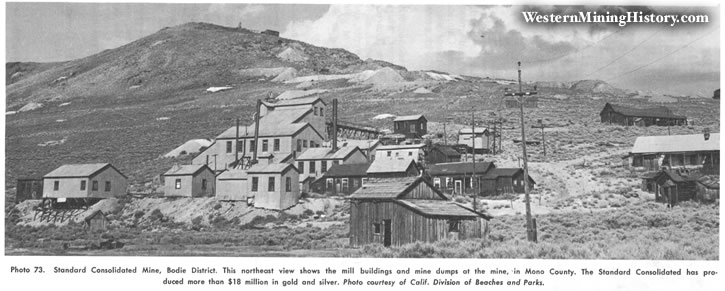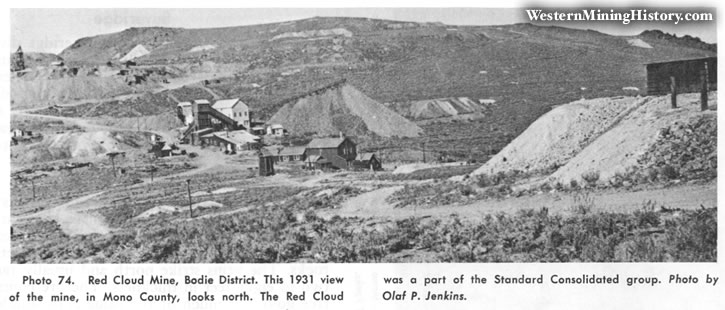Location
The Bodie district is in eastern Mono County about 18 miles southeast of Bridgeport.
History
Gold was discovered here in 1859 by William S. Bodey, and the district was organized in 1860, but activity was minor until 1872, when rich ore was discovered. From 1876 to about 1884, a rush was on with much production from rich but shallow deposits. By 1888, the district had yielded more than $18 million, but, thereafter until World War II, mining was confined to lower-grade deposits and reworking of old tailings.
From 1881 until 1914 timber was delivered to the mines by a narrow-gauge railroad from the east side of Mono Lake. Bodie was one of the first mining camps to use electricity (1893). Most of the important mines came under the control of J. S. Cain in 1915. The town became a noted tourist attraction in the 1940s, although many of the buildings had been destroyed by fire in 1932. The remaining portion became a state park in 1961. Studies have been made to determine the feasibility of working the entire Standard Hill area as a large open-pit operation. Bodie is the most productive district in the Basin Ranges, with a total production estimated to be valued at slightly more than $30 million. The district also has yielded more than 1 million ounces of silver.

Geology and Ore Deposits
A number of steep, north-trending silicified and brecciated zones and narrow quartz veins occur in Tertiary andesite. They are especially common in the Standard mine area, where the mineralized zone is as much as 1000 feet wide. Most of these veins and brecciated zones pinch out at depths of around 1000 feet, but some in the central portion of the district are reported to be deeper. The deepest shaft is 1200 feet. Most of the values have been recovered from above 500 feet. The ore contains finely disseminated free gold in both the quartz and silicified breccia with little or no sulfides. In only one vein, the Addonda Oro of the Southern Consolidated group, is pyrite abundant. The high-grade ore recovered in the early days from shallow workings yielded from $100 to $300 of gold and silver per ton.
Mines
Bechtel Cons. $200,000+, Bodie Tunnel $200,000+, Bulwar $428,000+, Mono S 122,000+, Southern Cons. $1 million+, Standard Cons. $18 million+, Syndicate $1 million+

Bibliography
Brown, R. A., 1908, The vein system of the Standard mine, Bodie, California: Trans. Am. Inst. Min. Engrs., vol. 38, pp. 343-357.
Cain, Ella M., 1956, The Story of Bodie, Fearon Publishers, San Francisco, 196 pp.
Crawford, J. J., 1896, Standard mine: California Min. Bur. Rept. 13, p. 231.
Eakle, A. 5., and Mclaughlin. R. D., 1919, Mono County, Bodie district: California Min. Bur. Rept. 15, pp. 149-160.
Tucker, W. B., and Sampson, R.J. 1940, Mono County, Southern Cons. and Standard Cons. mines: California Division of Mines Rept. 36, pp. 136-138.
Whiting, H. A., 1888, Bodie district: California Min. Bur. Rept. 8, pp. 382-401.